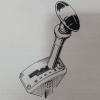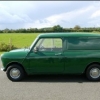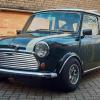Front Alignment Question
#1

Posted 13 May 2025 - 06:16 AM
Thanks
#2

Posted 13 May 2025 - 07:15 AM
Combined, you're measuring one wheel off the other. If you want to be accurate, let the car roll so you can reference where it's steering straight ahead & measure the tracking there.
#3

Posted 13 May 2025 - 07:26 AM
Edited by croc7, 13 May 2025 - 07:26 AM.
#4

Posted 13 May 2025 - 10:10 AM
Edited by 68+86auto, 13 May 2025 - 10:10 AM.
#5

Posted 14 May 2025 - 05:48 AM
So my question is - what size wheel is used for the Haynes manual specifications?
Because as you said the measurements change depending on wheel diameter.
#6

Posted 14 May 2025 - 06:26 AM
So my question is - what size wheel is used for the Haynes manual specifications?
Because as you said the measurements change depending on wheel diameter.
The factory manual specified the diameter (I'd need to check the value) and Haynes would've copied the value from the manual.
Edited by 68+86auto, 14 May 2025 - 06:26 AM.
#7

Posted 14 May 2025 - 06:53 AM
So my question is - what size wheel is used for the Haynes manual specifications?
Because as you said the measurements change depending on wheel diameter.

#8

Posted 12 June 2025 - 04:20 PM
Good information there. Wouldn't it have been easier to have the measurement taken from the rim of the wheel though?
#9

Posted 12 June 2025 - 04:27 PM
The 4 wheel alignment equipment we had at the dealership I used to work at was set up off the tyre rather than the rim aswell.
The equipment at the sports car manufacturer I now work for is set up on the rim.
#10

Posted 12 June 2025 - 05:46 PM
Good information there. Wouldn't it have been easier to have the measurement taken from the rim of the wheel though?
Well it is the tyre that is contacting the road, not the wheel, however some tyres are more consistent than others. Having said that though, I've not yest seen a machine that is able to attach to the tyre, they all seem to clip on to the wheel as at least there, there's something to grab on to.
#11

Posted 12 June 2025 - 10:50 PM
Good information there. Wouldn't it have been easier to have the measurement taken from the rim of the wheel though?
Before equipment became available with runout compensation in the 50s, it was common to use the tyre. Rims are quite often nowhere near true so if they were used for the alignment, they would easily put it out by 1mm or more. Wheel truing and even drum truing was once a thing. Tyres aren't perfect either but are going to be better than the rim. as well as this, the larger diameter allows for a more precise measurement.
The manual for one of the 1950s cars I work on says when using the Dunlop gauges, repeat the measurements three times and average the value.
 Screenshot 2025-06-13 084943.jpg 16.4K
0 downloads
Screenshot 2025-06-13 084943.jpg 16.4K
0 downloads
Sometimes I use an alignment tool like the following. It is installed between the tyres, zeroed and then the car is rolled so that the bar is then at the opposite position back/front. This means it uses the same point on the tyres and no runout compensation is required. It's a simple but accurate solution.
 sps-99361_ml.jpg 2.87K
0 downloads
sps-99361_ml.jpg 2.87K
0 downloads
What is odd to me is that in the UK, there are many manufacturers still selling alignment equipment that doesn't have runout compensation.
Runout compensation is done by spinning the wheel and adjusting the equipment so that the reading doesn't change when the wheel spins. Modern equipment does this automatically by pushing the car with the wheels on the ground.
Edited by 68+86auto, 12 June 2025 - 11:02 PM.
#12

Posted 13 June 2025 - 03:59 AM
Runout compensation is done by spinning the wheel and adjusting the equipment so that the reading doesn't change when the wheel spins. Modern equipment does this automatically by pushing the car with the wheels on the ground.
The AMC Machine I have has run out compensation.
1 user(s) are reading this topic
0 members, 1 guests, 0 anonymous users


















